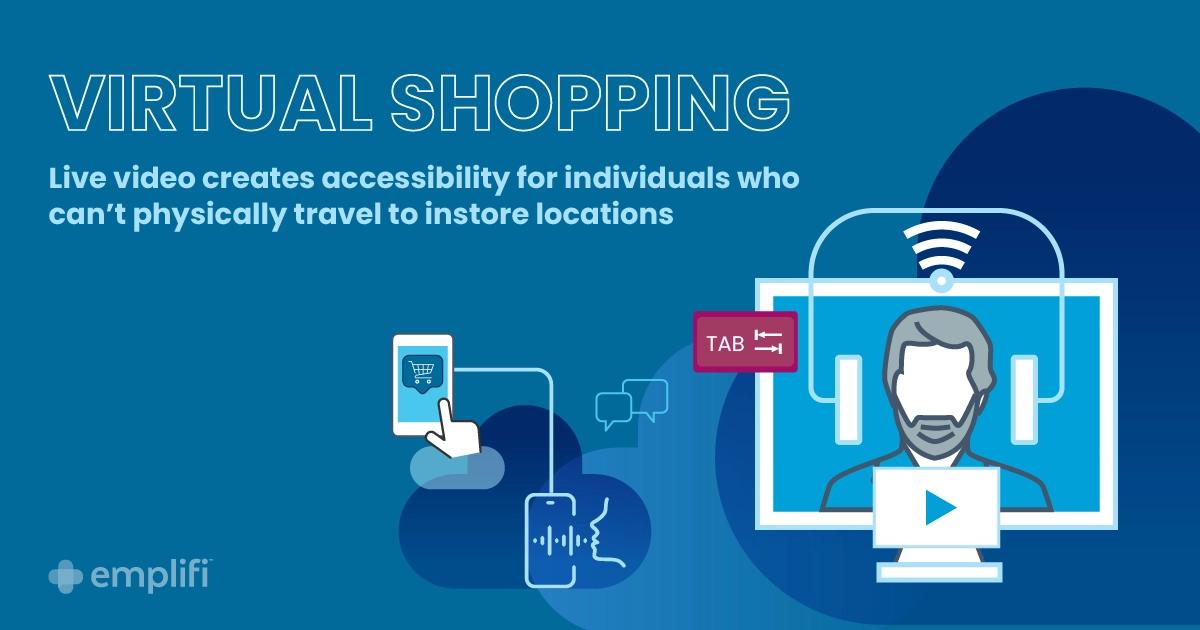Your eCommerce strategy might be leaving some people behind, but fear not, live video is here to connect, convert, and support a customer who deserves some personalized attention from your brand.
No business wants to lose consumers along their digital buying journey or post-purchase when they need customer support, but that's what happens to the majority of shoppers with disabilities as 65% abandon their purchase due to poor accessibility on eCommerce platforms. And it may even be more common than you think, as the Center for Disease Control and Prevention estimates that more than 1 in 4 people have some form of disability.
According to an annual survey of the top 1,000,000 home pages and domains, nearly half recorded as many as 50 “distinct accessibility errors” per page. That means that website accessibility is a challenge for all companies, but one that can be particularly costly to eCommerce brands.
In 2021, one study found that online retailers lost an estimated $828 million in online sales at Christmas due to inaccessible websites, and another study estimates that U.S.-based retailers may lose more than $6.9 billion annually to competitors with websites that provide more accessible customer experiences.
This challenge will only grow more complicated as the modern consumer evolves when, where, and how they shop online. Digital experiences can be simplified, captions can be added to videos, and colors can be properly tested, but most companies will still find gaps in their customer journey.
How can live video help? Let’s explore the connection between one-to-one live video shopping and improving the experience of consumers with disabilities.
Why accessible eCommerce matters
By making your eCommerce website accessible, you’re not only providing a better user experience for people with disabilities, but you’re also creating a more inclusive and welcoming environment for all users. Brands like Trader Joe’s have blended physical and digital accessibility to reach new customers and support their communities.
Web accessibility is crucial for people with disabilities, as it ensures equal access to information. Inaccessible web content can create unnecessary barriers, preventing people with visual, hearing, motor, or cognitive disabilities from meeting their needs.
Perhaps most importantly, customers with disabilities deserve the same quality of experience as other people without disabilities, and if those barriers aren’t removed, your brand may deal with more than just a lost purchase or an unsatisfied customer.
Lawsuits due to inaccessibility have risen significantly in the past few years. While compliance offerings do exist, it’s not always enough, or in some cases, not fully adequate in solving the accessibility problems for all disabilities.
Legislation in many countries – like the United States’ Americans with Disabilities Act – provide guidance on how you begin your own evaluation process.
How can live video support accessibility?
It’s important to think of live video shopping as more than just a potential visual or auditory medium to support customers with disabilities in either area.
One-to-one live video shopping products offer brands a direct touchpoint with customers of any need, and they provide consumers with a guided shopping experience. It’s a bridge to connect a variety of live commerce capabilities, but specifically for shoppers with disabilities it offers a channel for real-time communication.
Live video can provide a more detailed and interactive visual representation of products, helping customers with visual impairments make informed purchasing decisions. It can help answer questions for individuals with cognitive disabilities, and chat-based functionality can support those with hearing loss.
All customers today expect more convenient, personalized, and frictionless experiences. Here are a few specific ways live video shopping can help your brand do that for customers with disabilities:

Visual details for customers with hearing impairments
Customers can interact with the host or brand associate in real-time through video chat, allowing them to ask questions and get instant answers that an eCommerce website might not fully provide. This is particularly true if the site is missing captions on product demos or details that would be beneficial to customers who are deaf or hard of hearing.
Naturally, if a brand happens to feature signing associates – like Starbucks has deployed globally – there would be a unique opportunity to speak in a natural language for both the support team and potential customer who chooses to interact via video call.
Brands should ensure advisors are using noise-canceling headsets, or are able to move to a quieter part of the showroom if a customer has hearing impairments, in order to reduce noise interference.

Audio walk-throughs for customers with visual impairments
Live video platforms also offer the opportunity to connect customers who are blind or use an alternate method of communication to associates that can tailor product descriptions via audio rather than a video showcase.
The key is human-to-human interaction. Through live video shopping, customers with visual impairments can quickly solve problems versus relying solely on video audio or screen readers.
Support teams should be trained to avoid using features such as screen share, in-call chat, add-to-basket, and simply help the customer with their needs.

Shopping in comfort for customers with motor or dexterity impairments
Live video shopping is most directly applicable to customers who can’t easily navigate a physical store.
People with motor impairments can shop from the comfort of their own homes, and the in-app experience can provide simplified navigation features, making it easier for customers with motor impairments to navigate.
Live video shopping platforms can also include voice-activated controls, which can be helpful for customers with motor impairments who may have difficulty using a mouse or keyboard. Another consideration is the ability to deploy large buttons and text, making it easier for customers with dexterity impairments to click on links and read content.
How do I get started using live video shopping for customers with disabilities?
It’s important to remember that you can’t help customers if they can’t connect with you and your experts. Consider these steps when utilizing live video shopping to close the experience gap for customers with disabilities.
Evaluate your accessibility gaps: Take an honest look at where the customer experience might stumble for your audience. There are tools available to help, but it’s best to understand where your customers might find barriers to your products and services.
Choose a live video shopping platform: Selecting the right partner and stage for accessible customer engagement is key, and there are best practices to consider when selecting a platform. Overall, the medium must allow a comprehensive customer experience and a way to deploy that for all customers.
Carefully select and train your associates: Implementing engagement strategies by persona type is helpful in making sure each interaction provides the experience that both you and the customer expect. Just do what you can to be prepared and deliver support.
Gather feedback: Give your customers a voice, and be open to feedback. In this era of customer experience, 32% of customers stop doing business with a brand they love after a bad experience.
Promote your new channels: As mentioned above, accessibility is a challenge across most digital channels. So don’t forget to let customers know there are other ways to engage once your plan is delivered.
Learn how to use live video shopping to improve accessibility for eCommerce
At Emplifi, we specialize in creating one-to-one video shopping platforms that transform the customer experience for all customers. Our technology has helped some of the world's top brands increase conversions and average spend.
Want to see how we can take your eCommerce strategy to the next level? Speak with an Emplifi expert today.

































